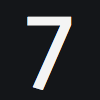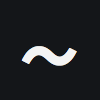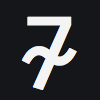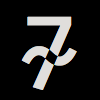There isn't a way to encode a superposition of two arbitrary characters in Unicode.
In some encodings predating even 8-bit computers, you could overstrike arbitrary characters by transmitting backspace, so è would be e backspace `. This did not work on early computer screens, but did on mechanical line printers!
There are combining characters in Unicode, including 7̴ and 7̃. Just not that particular one.
The closest thing to support for combining arbitrary characters into a single grapheme is the Zero-Width Joiner (zwidge; U+200D), which for example is used to make 👩 (woman) + ZWJ + ⚕ (caduceus) = 👩⚕️ (female health worker). In emoji and many scripts, such as Devanagari and Arabic, this means something other than superimposing the symbols.
OpenType fonts support ligatures, so a given font might define 7~ or 7 ZWJ ~ as that symbol. Palatino Linotype is one that supports interrobang (‽) this way.
Generally, though, you would need to communicate this to your application some other way, such as embedding a custom font or transmitting the glyph as an inline vector graphic.




